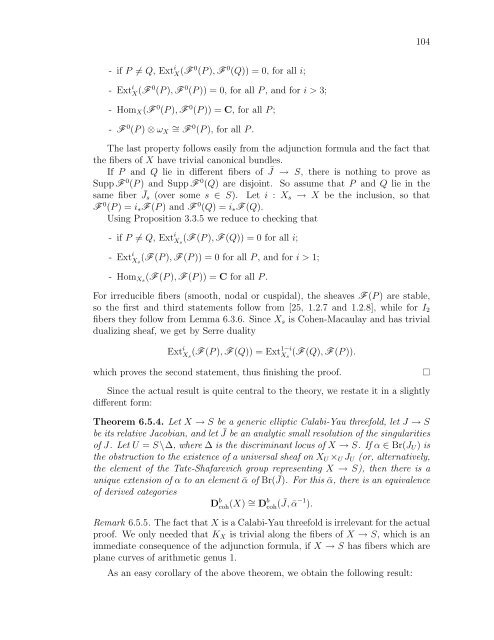derived categories of twisted sheaves on calabi-yau manifolds
derived categories of twisted sheaves on calabi-yau manifolds
derived categories of twisted sheaves on calabi-yau manifolds
You also want an ePaper? Increase the reach of your titles
YUMPU automatically turns print PDFs into web optimized ePapers that Google loves.
- if P = Q, Ext i<br />
X(F 0 (P ), F 0 (Q)) = 0, for all i;<br />
- Ext i<br />
X(F 0 (P ), F 0 (P )) = 0, for all P , and for i > 3;<br />
- HomX(F 0 (P ), F 0 (P )) = C, for all P ;<br />
- F 0 (P ) ⊗ ωX ∼ = F 0 (P ), for all P .<br />
104<br />
The last property follows easily from the adjuncti<strong>on</strong> formula and the fact that<br />
the fibers <str<strong>on</strong>g>of</str<strong>on</strong>g> X have trivial can<strong>on</strong>ical bundles.<br />
If P and Q lie in different fibers <str<strong>on</strong>g>of</str<strong>on</strong>g> ¯ J → S, there is nothing to prove as<br />
Supp F 0 (P ) and Supp F 0 (Q) are disjoint. So assume that P and Q lie in the<br />
same fiber ¯ Js (over some s ∈ S). Let i : Xs → X be the inclusi<strong>on</strong>, so that<br />
F 0 (P ) = i∗F (P ) and F 0 (Q) = i∗F (Q).<br />
Using Propositi<strong>on</strong> 3.3.5 we reduce to checking that<br />
- if P = Q, Ext i Xs (F (P ), F (Q)) = 0 for all i;<br />
- Ext i<br />
Xs (F (P ), F (P )) = 0 for all P , and for i > 1;<br />
- HomXs(F (P ), F (P )) = C for all P .<br />
For irreducible fibers (smooth, nodal or cuspidal), the <str<strong>on</strong>g>sheaves</str<strong>on</strong>g> F (P ) are stable,<br />
so the first and third statements follow from [25, 1.2.7 and 1.2.8], while for I2<br />
fibers they follow from Lemma 6.3.6. Since Xs is Cohen-Macaulay and has trivial<br />
dualizing sheaf, we get by Serre duality<br />
Ext i<br />
Xs<br />
(F (P ), F (Q)) = Ext1−i(F<br />
(Q), F (P )).<br />
Xs<br />
which proves the sec<strong>on</strong>d statement, thus finishing the pro<str<strong>on</strong>g>of</str<strong>on</strong>g>.<br />
Since the actual result is quite central to the theory, we restate it in a slightly<br />
different form:<br />
Theorem 6.5.4. Let X → S be a generic elliptic Calabi-Yau threefold, let J → S<br />
be its relative Jacobian, and let ¯ J be an analytic small resoluti<strong>on</strong> <str<strong>on</strong>g>of</str<strong>on</strong>g> the singularities<br />
<str<strong>on</strong>g>of</str<strong>on</strong>g> J. Let U = S \∆, where ∆ is the discriminant locus <str<strong>on</strong>g>of</str<strong>on</strong>g> X → S. If α ∈ Br(JU) is<br />
the obstructi<strong>on</strong> to the existence <str<strong>on</strong>g>of</str<strong>on</strong>g> a universal sheaf <strong>on</strong> XU ×U JU (or, alternatively,<br />
the element <str<strong>on</strong>g>of</str<strong>on</strong>g> the Tate-Shafarevich group representing X → S), then there is a<br />
unique extensi<strong>on</strong> <str<strong>on</strong>g>of</str<strong>on</strong>g> α to an element ¯α <str<strong>on</strong>g>of</str<strong>on</strong>g> Br( ¯ J). For this ¯α, there is an equivalence<br />
<str<strong>on</strong>g>of</str<strong>on</strong>g> <str<strong>on</strong>g>derived</str<strong>on</strong>g> <str<strong>on</strong>g>categories</str<strong>on</strong>g><br />
D b coh(X) ∼ = D b coh( ¯ J, ¯α −1 ).<br />
Remark 6.5.5. The fact that X is a Calabi-Yau threefold is irrelevant for the actual<br />
pro<str<strong>on</strong>g>of</str<strong>on</strong>g>. We <strong>on</strong>ly needed that KX is trivial al<strong>on</strong>g the fibers <str<strong>on</strong>g>of</str<strong>on</strong>g> X → S, which is an<br />
immediate c<strong>on</strong>sequence <str<strong>on</strong>g>of</str<strong>on</strong>g> the adjuncti<strong>on</strong> formula, if X → S has fibers which are<br />
plane curves <str<strong>on</strong>g>of</str<strong>on</strong>g> arithmetic genus 1.<br />
As an easy corollary <str<strong>on</strong>g>of</str<strong>on</strong>g> the above theorem, we obtain the following result:
















